Angel theme by Sim24
Download: Angel.p3t

(1 background)
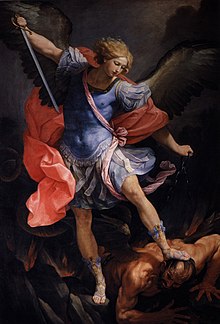
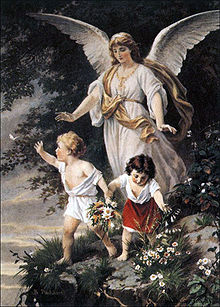

In Abrahamic religious traditions (such as Judaism, Christianity, and Islam) and some sects of other belief-systems like Hinduism and Buddhism, an angel is a heavenly supernatural or spiritual being. In monotheistic belief-systems, such beings are under service of the supreme deity (i.e. God).
Abrahamic religions often depict angels as benevolent celestial intermediaries between God and humanity.[1][2] Other roles include protectors and guides for humans, such as guardian angels and servants of God.[3] Abrahamic religions describe angelic hierarchies, which vary by religion and sect. Some angels have specific names (such as Gabriel or Michael) or titles (such as seraph or archangel). Malevolent angels are often believed to have been expelled from Heaven and called fallen angels. In many such religions, the Devil (or devils) are identified with such angels.
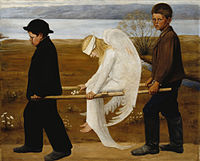
Angels in art are often identified with bird wings,[4] halos,[5] and divine light. They are usually shaped like humans of extraordinary beauty, though this is not always the case—sometimes, they can be portrayed in a frightening, inhuman manner.[6]
Etymology[edit]
The word angel arrives in modern English from Old English engel (with a hard g) and the Old French angele.[7] Both of these derive from Late Latin angelus, which in turn was borrowed from Late Greek ἄγγελος angelos (literally "messenger").[8] Τhe word's earliest form is Mycenaean a-ke-ro, attested in Linear B syllabic script.[9] According to the Dutch linguist R. S. P. Beekes, ángelos itself may be "an Oriental loan, like ἄγγαρος (ángaros, 'Persian mounted courier')."[10]
The rendering of "ángelos" is the Septuagint's default translation of the Biblical Hebrew term malʼākh, denoting simply "messenger" without connoting its nature. In the Latin Vulgate, this meaning becomes bifurcated: when malʼākh or ángelos is supposed to denote a human messenger, words like nuntius or legatus are applied. If the word refers to some supernatural being, the word angelus appears. Such differentiation has been taken over by later vernacular translations of the Bible, early Christian and Jewish exegetes and eventually modern scholars.[11]
Background[edit]
The concept of angels is historically best to be understood from different ideas of the concept of God throughout history. In polytheistic and animistic worldviews, supernatural powers (i.e. deities, spirits, daemons, etc.) were assigned to different natural phenomena.[12](p102) Within a monotheistic framework, these powers were reconsidered to be servants of the supreme deity, turning autonomous supernatural beings into "angels".[12](p102)
By that, are supernatural powers controlling or influencing humanities' perception of the world, including natural phenomena and humans, ultimately under control of a supreme God.[12](p102) Prominent angels, such as Michael and Gabriel, reflect a connection to the Chief Semitic deity El. Even "bad" angels such as Satan, Samael, Iblis etc., can be understood as an operating force within the nature of humans, as responsible for selfish tendencies.[12](p102)
The idea of angels in early Hebrew scripture as supernatural agents is absent.[13] Instead, the Hebrew deity intervenes in human affairs, mostly by means of punishment.[14] Only in later thought of post-exilic and prophetic writings, the Biblical deity is conceptualized as distant and more merciful, his interventions replaced by the idea of angels.[14] However, such angels still carry out the gruesome attributes of God and can be both benevolent and malevolent.[14] The notion of angels as embodiment of good emerges only under influence of Zoroastrianism, in which the Devil is conceived as the principle of evil, with a hosts of demons, in battle with the holy entities (Aməša Spəṇta) created by Ahura Mazda (principle of good).[14][13]
Influence of dualistic tendencies and replacement of divine powers by angels is evident from the Qumram writings. In the Angelic Liturgy, the Hebrew term elim (deities, heavenly powers) is used for angelic beings and not for God.[15](p23) The War Scroll speaks about angels of light fighting against demonic beings of darkness.[15](p20)
Zoroastrianism[edit]
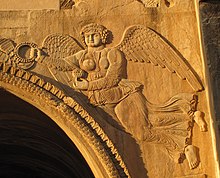
In Zoroastrianism there are different angel-like figures. For example, each person has one guardian angel, called Fravashi. They patronize human beings and other creatures, and also manifest God's energy. The Amesha Spentas have often been regarded as angels, although there is no direct reference to them conveying messages,[16] but are rather emanations of Ahura Mazda ("Wise Lord", God); they initially appeared in an abstract fashion and then later became personalized, associated with various aspects of creation.[17]
Judaism[edit]
In Judaism, angels (Hebrew: מַלְאָךְ mal’āḵ; "messenger"), are understood through interpretation of the Tanakh and in a long tradition as supernatural beings who stand by God in heaven, but are strictly to be distinguished from God (YHWH) and are subordinate to him. Occasionally, they can show selected people God's will and instructions.[18] In the Jewish tradition they are also inferior to humans since they have no will of their own and are able to carry out only one divine command.[19]
Hebrew Bible[edit]
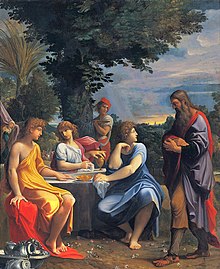

The Torah uses the Hebrew terms מלאך אלהים (mal'āk̠ 'ĕlōhîm; "messenger of God"), מלאך יהוה (mal'āk̠ Yahweh; "messenger of the Lord"), בני אלהים (bənē 'ĕlōhîm; "sons of God") and הקודשים (haqqôd̠əšîm; "the holy ones") to refer to beings traditionally interpreted as angels. Later texts use other terms, such as העליונים (hā'elyônîm; "the upper ones").[citation needed]
The term 'מלאך' ('mal'āk̠') is also used in other books of the Hebrew Bible. In the early stages of Hebrew writings, the term refers to human messengers, not to supernatural entities.[14][20] A human messenger might be a prophet or priest, such as Malachi, "my messenger"; the Greek superscription in the Septuagint translation states the Book of Malachi was written "by the hand of his messenger" ἀγγέλου (angélu). Examples of a supernatural messenger[21] are the "Malak YHWH", who is either a messenger from God,[22] an aspect of God (such as the logos),[23] or God himself as the messenger (the "theophanic angel.")[21][24]
Michael D. Coogan notes that it is only in the late books that the terms "come to mean the benevolent semi-divine beings familiar from later mythology and art."[25] Daniel is the biblical book to refer to individual angels by name,[26] mentioning Gabriel in Daniel 9:21 and Michael in Daniel 10:13. These angels are part of Daniel's apocalyptic visions and are an important part of apocalyptic literature.[25][27]
In Daniel 7, Daniel receives a dream-vision from God. [...] As Daniel watches, the Ancient of Days takes his seat on the throne of heaven and sits in judgement in the midst of the heavenly court [...] an [angel] like a son of man approaches the Ancient One in the clouds of heaven and is given everlasting kingship.[28]
Coogan explains the development of this concept of angels: "In the postexilic period, with the development of explicit monotheism, these divine beings—the 'sons of God' who were members of the Divine Council—were in effect demoted to what are now known as 'angels', understood as beings created by God, but immortal and thus superior to humans."[25] This conception of angels is best understood in contrast to demons and is often thought to be "influenced by the ancient Persian religious tradition of Zoroastrianism, which viewed the world as a battleground between forces of good and forces of evil, between light and darkness."[25] One of these is hāššāṭān, a figure depicted in (among other places) the Book of Job.
Rabbinic Judaism[edit]
According to Rabbinic Judaism, the angels have no bodies, but are eternally living creatures created out of fire. The Babylonian Talmud reads as "The Torah was not given to ministering angels." (לא נתנה תורה למלאכי השרת) usually understood as a concession to human's imperfection, in contrast to the angels.[29] Thus, they occasionally appear in Midrashim as competition with humans.[30] The angels as heavenly beings, strictly following the laws of God, become jealous of God's affection for man. Humans, by following the Torah, in prayer, by resisting evil instincts (yetzer hara) and by teshuva, are preferred to the flawless angels. As a result, they are also inferior to humans in the Jewish tradition. In the Midrash, the plural of El (Elohim) used in Genesis in relation to the creation of human beings is explained by the presence of angels: God therefore consulted with the angels, but made the final decision alone. This story serves as an example, teaching that the powerful should also consult with the weak. God's own final decision highlights God's undisputable omnipotence.[30]
In post-Biblical Judaism, certain angels took on particular significance and developed unique personalities and roles. Although these archangels were believed to rank among the heavenly host, no systematic hierarchy ever developed. Metatron is considered one of the highest of the angels in Merkabah and Kabbalah mysticism and often serves as a scribe; he is briefly mentioned in the Talmud[31] and figures prominently in Merkabah mystical texts. Michael, who serves as a warrior[32] and advocate for Israel (Daniel 10:13), is looked upon particularly fondly.[33] Gabriel is mentioned in the Book of Daniel (Daniel 8:15–17) and briefly in the Talmud,[34] as well as in many Merkabah mystical texts. There is no evidence in Judaism for the worship of angels, but there is evidence for the invocation and sometimes even conjuration of angels.[26]
Philo of Alexandria identifies the angel with the Logos inasmuch as the angel is the immaterial voice of God. The angel is something different from God himself, but is conceived as God's instrument.[35]
Four classes of ministering angels minister and utter praise before the Holy One, blessed be He: the first camp (led by) Michael on His right, the second camp (led by) Gabriel on His left, the third camp (led by) Uriel before Him, and the fourth camp (led by) Raphael behind Him; and the Shekhinah of the Holy One, blessed be He, is in the centre. He is sitting on a throne high and exalted[36]
Later interpretations[edit]
According to Kabbalah, there are four worlds and our world is the last world: the world of action (Assiyah). Angels exist in the worlds above as a 'task' of God. They are an extension of God to produce effects in this world. After an angel has completed its task, it ceases to exist. The angel is in effect the task. This is derived from the book of Genesis when Abraham meets with three angels and Lot meets with two. The task of one of the angels was to inform Sara and Abraham of their coming child. The other two were to save Lot and to destroy Sodom and Gomorrah.[26]
Jewish philosopher Maimonides explained his view of angels in his Guide for the Perplexed II:4 and II
... This leads Aristotle in turn to the demonstrated fact that God, glory and majesty to Him, does not do things by direct contact. God burns things by means of fire; fire is moved by the motion of the sphere; the sphere is moved by means of a disembodied intellect, these intellects being the 'angels which are near to Him', through whose mediation the spheres move ... thus totally disembodied minds exist which emanate from God and are the intermediaries between God and all the bodies [objects] here in this world.
— Guide for the Perplexed II:4, Maimonides
Maimonides had a neo-Aristotelian interpretation of the Bible. Maimonides writes that to the wise man, one sees that what the Bible and Talmud refer to as "angels" are actually allusions to the various laws of nature; they are the principles by which the physical universe operates.
For all forces are angels! How blind, how perniciously blind are the naive?! If you told someone who purports to be a sage of Israel that the Deity sends an angel who enters a woman's womb and there forms an embryo, he would think this a miracle and accept it as a mark of the majesty and power of the Deity, despite the fact that he believes an angel to be a body of fire one third the size of the entire world. All this, he thinks, is possible for God. But if you tell him that God placed in the sperm the power of forming and demarcating these organs, and that this is the angel, or that all forms are produced by the Active Intellect; that here is the angel, the "vice-regent of the world" constantly mentioned by the sages, then he will recoil.– Guide for the Perplexed II:4
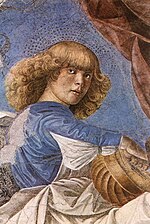

Individuals[edit]
From the Jewish Encyclopedia, entry "Angelology".[26]
- Michael (archangel) (translation: who is like God?), kindness of God, and stands up for the children of mankind[37]
- Gabriel (archangel) (translation: God is my strength), performs acts of justice and power
(Only these two angels are mentioned by name in the Hebrew Bible; the rest are from extra-biblical tradition.)
- Jophiel (translation: Beauty of God), expelled Adam and Eve from the Garden of Eden holding a flaming sword and punishes those who transgress against God
- Metatron, heavenly scribe of God
- Raphael (archangel) (translation: It is God who heals), God's healing force
- Uriel (archangel) (translation: God is my light), leads humanity to destiny
- Samael (archangel) (translation: Venom of God), angel of death—see also Malach HaMavet (translation: the angel of death)
- Sandalphon (archangel) (translation: bringing together), battles Samael and brings mankind together
Christianity[edit]

In the early stage, the Christian concept of an angel characterized the angel as a 'messenger' of God. The word "angel" can be drawn to the term or role of a "messenger" throughout the Bible in both old and new testaments - (Hebrews 1:14) calls them "ministering [or serving] spirits", sent by God to aid the "heirs of salvation".[38] Later came identification of individual angelic messengers: Gabriel, Michael, Raphael, and Uriel.[39] Then, in the space of slightly over two centuries (from the 3rd to the 5th) the image of angels took on definite characteristics both in theology and in art.[40] Ellen Muehlberger has argued that in Late Antiquity, angels were conceived of as one type of being among many, whose primary purpose was to guard and to guide Christians.[41]
Bible[edit]
Angels are represented throughout Bibles as spiritual beings which are intermediate between God and humanity: "For thou hast made him [man] a little lower than the angels, and hast crowned him with glory and honour" (Psalms 8:4–5). Christians, based on Psalms and Genesis 2:1, believe that angels were the first beings created by God before the creation of Earth (Psalms 148:2–5; Colossians 1:16). Greek translations of the Hebrew Bible refer to intermediary beings as angels, instead of daimons, thus giving raise to a distinction between demons and angels.[42] In the Old Testament, both benevolent and fierce angels are mentioned, but never called demons. The symmetry lies between angels sent by God, and intermediary spirits of foreign deities, not in good and evil deeds.[43]
In the New Testament, the existence of angels, just like that of demons, is taken for granted.[44] They can intervene and intercede on behalf of humans. Angels protect the righteous (Matthew 4:6, Luke 4:11). They dwell in the heavens (Matthew 28:2, John 1:51), act as God's warriors (Matthew 26:53) and worship God (Luke 2:13).[45] In the parable of the Rich man and Lazarus, angels behave as psychopomps. The Resurrection of Jesus features angels, telling the woman that Jesus is no longer in the tomb, but has risen from the dead.[46]
Interaction with humans[edit]

Forget not to show love unto strangers: for thereby some have entertained angels unawares.—Hebrews 13:2
According to Jesus' statement, angels of Heaven don't marry (Matthew 22:30, Mark 12:25, and Luke 20:34–46).[47]
Three separate cases of angelic interaction deal with the births of John the Baptist and Jesus. In (Luke 1:11), an angel appears to Zechariah to inform him that he will have a child despite his old age, thus proclaiming the birth of John the Baptist. In Luke 1:26, Gabriel visits Mary in the Annunciation to foretell the birth of Jesus. Angels proclaim the birth of Jesus in the Adoration of the shepherds in Luke 2:10.[48]
According to Matthew 4:11, after Jesus spent 40 days in the desert, "...the Devil left him and, behold, angels came and ministered to him." In Luke 22:43 an angel comforts Jesus during the Agony in the Garden.[49] In Matthew 28:5 an angel speaks at the empty tomb, following the Resurrection of Jesus and the rolling back of the stone by angels.[48]
In 1851 Pope Pius IX approved the Chaplet of Saint Michael based on the 1751 reported private revelation from archangel Michael to the Carmelite nun Antonia d'Astonac.[50] In a biography of
One Reply to “Angel”
Comments are closed.

For those that wanted only this angel